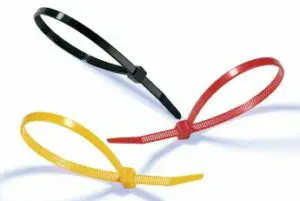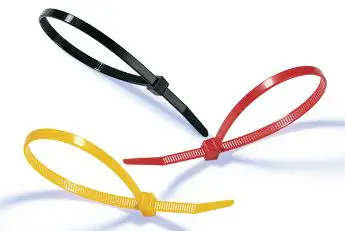Contents
- 1 Introduction: Exploring Beyond Zip Ties
- 2 Twist Ties: Flexible and Adjustable
- 3 Velcro Straps: Reusable Cable Management
- 4 Bungee Cords: Flexible and Secure
- 5 Reusable Cable Ties: Traditional Design with Reusability
- 6 String or Rope: Simple and Versatile
- 7 Snap-In Cable Clips: Targeted Cable Organization
- 7.1 Designed for Cable Organization:
- 7.2 Plastic or Metal Construction:
- 7.3 Easily Attach to Surfaces:
- 7.4 Use Cases in Managing Cables Effectively:
- 7.5 Binder Clips: Repurposing for Cable Management
- 7.6 Versatile and Repurposable:
- 7.7 Material Composition:
- 7.8 Used for Lightweight Cable Management:
- 7.9 Simple and Effective Application:
- 8 Adhesive Cable Holders: Sticky Solutions
- 8.1 Introduction to Adhesive Cable Holders:
- 8.2 Plastic or Rubber Construction:
- 8.3 Sticky Backing for Surface Attachment:
- 8.4 Non-Intrusive Nature and Ease of Installation:
- 8.5 Elastic Bands: Simple and Reusable
- 8.6 Exploring Elastic Bands as Alternatives:
- 8.7 Material Composition—Rubber or Elastic:
- 8.8 Versatility in Bundling and Securing:
- 8.9 Simple and Reusable Nature:
- 9 Duct Tape or Gaffer Tape: Temporary Solutions
- 10 Conclusion: Choosing the Right Alternative
Introduction: Exploring Beyond Zip Ties
Zip ties, also known as cable ties, have long been the go-to solution for bundling, organizing, and securing various items due to their simplicity and versatility. These handy fasteners, made of plastic and featuring a ratcheting mechanism, have found their way into countless applications, from managing cables to makeshift repairs. However, as diverse as their uses are, there comes a point where we must explore beyond the familiar realm of zip ties.
In our journey of organizing and fastening, it becomes evident that alternatives to traditional zip ties are not just a luxury but a necessity in various situations. Whether you’re seeking a more adjustable option, a reusable solution, or something specific for cable management, the world of fastening tools offers a spectrum of alternatives waiting to be discovered. This prompts us to pose a central question: “What are the alternatives to traditional zip ties, and how do they compare?” Join us as we embark on an exploration of alternatives that promise to redefine the way we fasten and organize, stepping beyond the confines of the conventional zip tie.
Twist Ties: Flexible and Adjustable
When seeking alternatives to traditional zip ties, one contender that emerges as a versatile solution is the humble twist tie. Composed of a wire core encased in a flexible coating, usually made of plastic or rubber, twist ties offer a unique set of characteristics that set them apart in the realm of fastening tools.
Material Composition:
Twist ties are crafted with a simple yet effective design. The core is often made of wire, providing a sturdy foundation for the tie’s fastening capabilities. This wire is then enveloped in a flexible coating, commonly composed of plastic or rubber. This construction not only ensures durability but also imparts a degree of malleability to the twist tie.
Advantages of Twist Ties:
Reusability: One of the standout features of twist ties is their reusability. Unlike traditional zip ties that are single-use, twist ties can be undone and adjusted as needed. This makes them an eco-friendly and cost-effective option for various applications.
Flexibility: The inherent flexibility of twist ties allows them to conform to the shape of the items being fastened. This makes them particularly effective for securing objects of varying sizes and shapes, providing a snug fit without excessive pressure.
Ease of Adjustment: Twist ties are incredibly easy to adjust. Their simple design allows users to tighten or loosen the tie with minimal effort, providing a level of adaptability that is often not achievable with rigid zip ties.
In the realm of fastening, twist ties present a dynamic alternative, combining the strength of wire with the adaptability of a flexible coating. Whether you’re bundling cables, securing bags, or organizing various items, twist ties prove to be a valuable tool in the pursuit of a flexible and adjustable fastening solution.
Velcro Straps: Reusable Cable Management
In the quest for alternatives to traditional zip ties, Velcro straps emerge as a highly adaptable and reusable solution, particularly in the realm of cable management. These innovative fasteners utilize hook-and-loop technology, offering a versatile and user-friendly approach to bundling and organizing items.
Hook-and-Loop Fasteners:
At the heart of Velcro straps lies the hook-and-loop fastening system. Consisting of two components—hook tape and loop tape—these straps employ tiny hooks on one side that latch onto loops on the other. This design allows for secure fastening while remaining easily adjustable, making Velcro straps a go-to choose for those seeking a reusable and flexible solution.

Fabric Construction:
Velcro straps are typically constructed from fabric, providing a sturdy yet pliable material for fastening. The fabric composition enhances their durability, ensuring that they can withstand repeated use without compromising their integrity. This fabric construction also contributes to their versatility, allowing them to be easily cut to custom lengths when needed.
Reusable Solution:
One of the defining features of Velcro straps is their reusability. Unlike traditional zip ties that necessitate cutting and replacing for adjustments, Velcro straps can be opened and closed multiple times. This makes them an environmentally friendly option and a cost-effective investment for various applications.
Use Cases in Cable Management and Organization:
Velcro straps find their niche in cable management, offering an organized and tangle-free solution for wires and cables. Their adjustable nature allows users to bundle cables of different lengths securely, preventing a cluttered and chaotic workspace. Additionally, Velcro straps can be employed in various organizational tasks, such as bundling tools, securing rolled-up mats, or keeping sports equipment neatly arranged.
In the realm of fastening tools, Velcro straps stand out as a reusable and versatile alternative. Whether you’re tidying up your home office cables, organizing equipment in a workshop, or streamlining the chaos of cords behind your entertainment center, Velcro straps prove to be an invaluable asset in the pursuit of efficient and reusable cable management.
Bungee Cords: Flexible and Secure
When exploring alternatives to conventional zip ties, bungee cords emerge as a dynamic and elastic solution, bringing a new level of versatility to the realm of fastening tools. These ingenious cords, characterized by their elasticity and hooked ends, offer a unique set of advantages, making them an excellent choice for various applications.
Versatility and Elasticity:
Bungee cords are renowned for their versatility, capable of stretching to accommodate a range of sizes and shapes. This elasticity is attributed to their construction, typically comprising multiple elastic cords intertwined to form a robust yet flexible unit. The inherent stretchability of bungee cords allows them to adapt to the contours of items being secured, making them well-suited for tasks that demand flexibility.
Material Composition:
The core material of bungee cords is elastic, often made from rubber or synthetic materials with elastic properties. This elastic core provides the cords with the ability to stretch and retract, creating a dynamic and adaptable fastening tool. Additionally, bungee cords are equipped with hooks on each end, adding to their convenience and ease of use.
Advantages in Securing Larger Items:
One of the standout advantages of bungee cords is their efficacy in securing larger items. Whether it’s bundling camping equipment, securing luggage on a roof rack, or fastening items during transport, bungee cords excel in handling substantial loads. The combination of their elastic properties and sturdy hooks ensures a secure and reliable hold, even for sizable and irregularly shaped objects.
Providing Flexibility in Fastening:
Flexibility is a hallmark feature of bungee cords. Their ability to stretch and contract makes them adaptable to a variety of fastening scenarios. This flexibility proves invaluable in situations where a rigid fastening tool may fall short, allowing users to achieve a secure hold without the constraints of a fixed length.
In the realm of fastening solutions, bungee cords shine as a flexible and secure alternative to traditional zip ties. From securing camping gear to bundling items for transport, the versatility and elasticity of bungee cords make them an indispensable tool in the toolkit of those seeking dynamic and adaptable fastening options.
Reusable Cable Ties: Traditional Design with Reusability
In the quest for alternatives to traditional zip ties, the evolution of fastening tools brings us to the realm of reusable cable ties. These ties marry the familiar and efficient design of zip ties with a forward-thinking twist—reusability. Let’s delve into the features that make reusable cable ties a standout choice for those seeking the perfect balance between traditional design and adjustability.
Designed for Multiple Uses:
Reusable cable ties are engineered with longevity in mind. Unlike their single-use counterparts, these ties are crafted to endure multiple applications and adjustments. This design not only contributes to environmental sustainability but also proves cost-effective over the long term.
Material Composition:
The robust nature of reusable cable ties is often attributed to their material composition, which typically includes durable substances such as nylon or other resilient plastics. This ensures that the ties maintain their integrity through repeated use, standing up to the demands of various fastening tasks.
Traditional Zip Tie Design:
At first glance, reusable cable ties bear a striking resemblance to traditional zip ties. They feature a band with teeth that securely engage when tightened, providing a reliable and firm hold. This design ensures that users can leverage the familiar and efficient aspects of traditional zip ties while enjoying the added benefit of reusability.
Release Mechanism for Adjustability:
What sets reusable cable ties apart is the inclusion of a release mechanism. This thoughtful addition allows users to adjust, release, and reuse the ties without the need for cutting. The release mechanism enhances the versatility of these ties, providing a level of adjustability that is often lacking in their disposable counterparts.
Whether you’re organizing cables in a home office, securing items for a DIY project, or bundling garden hoses in the backyard, reusable cable ties offer a versatile and eco-friendly solution. By combining the time-tested design of traditional zip ties with the innovation of a release mechanism, these ties empower users with the flexibility to fasten, adjust, and reuse with ease.
String or Rope: Simple and Versatile
In the world of fastening tools, sometimes simplicity reigns supreme. Strings or ropes, with their time-honored and straightforward design, emerge as readily available alternatives to traditional zip ties. Let’s unravel the qualities that make strings or ropes a simple yet versatile choice for a myriad of fastening applications.
Readily Available Alternatives:
Strings or ropes are among the most accessible fastening tools. Found in households, workshops, and outdoor settings, they provide a straightforward solution that doesn’t require a trip to the store. Their ubiquity makes them an instant go-to for quick fixes, makeshift solutions, and various applications where a fastening tool is needed.
Natural or Synthetic Fiber Construction:
Strings or ropes showcase diversity in their construction, with options available in both natural and synthetic fibers. Natural fibers, such as cotton or hemp, bring a rustic charm and biodegradability to the table. On the other hand, synthetic fibers like nylon or polyester offer durability and resilience in challenging conditions.
Versatility in Various Applications:
The versatility of strings or ropes knows no bounds. Their applications span a wide range of scenarios, from bundling firewood, securing camping gear, and fastening DIY projects to crafting temporary repairs and even creating art. The flexibility of strings and ropes allows users to adapt them to the unique requirements of different tasks.
Whether you find yourself in a DIY project, outdoor adventure, or everyday household task, strings or ropes can be readily enlisted to fulfill your fastening needs. Their simplicity, combined with the availability of various materials, grants users the freedom to choose a fastening solution that aligns with the specific demands of the task at hand. As we navigate the world of fastening alternatives, the unassuming string or rope stands out as a testament to the enduring power of simplicity and versatility.

Snap-In Cable Clips: Targeted Cable Organization
In the pursuit of cable organization, a specialized solution takes center stage: the snap-in cable clip. These purpose-built clips offer a tailored approach to managing cables effectively, providing a seamless and targeted solution for those seeking an organized and clutter-free environment. Let’s unravel the features that make snap-in cable clips a standout choice in the realm of cable management.
Designed for Cable Organization:
Snap-in cable clips are engineered with a specific focus on cable organization. These clips recognize the challenges posed by tangled cords and offer a dedicated solution to keep cables neat, tidy, and easily accessible. Their design takes into account the varying sizes and types of cables commonly found in modern spaces.
Plastic or Metal Construction:
The construction of snap-in cable clips is typically either plastic or metal, ensuring durability and reliability in their application. Plastic clips are lightweight and often blend seamlessly with the surrounding environment, while metal clips bring added sturdiness and a sleek aesthetic. This construction is tailored to withstand the demands of cable management in various settings.
Easily Attach to Surfaces:
The hallmark feature of snap-in cable clips lies in their effortless attachment to surfaces. Whether it’s the edge of a desk, the back of an entertainment center, or the underside of a table, these clips are designed for easy installation. This snap-in mechanism eliminates the need for adhesives or complex installations, ensuring a hassle-free experience for users.
Use Cases in Managing Cables Effectively:
Snap-in cable clips find their niche in managing cables effectively across diverse scenarios. They excel in creating an organized workspace by keeping charging cables, power cords, and other cables in place. Whether it’s creating a clean aesthetic in a home office, minimizing clutter around entertainment systems, or streamlining cables in workshops, these clips offer a targeted solution for effective cable management.
In the world of cable organization, snap-in cable clips emerge as a dedicated and efficient tool. By combining a specialized design with user-friendly installation, these clips cater to the unique challenges posed by cable clutter. Say goodbye to tangled cords and hello to an organized space where cables are neatly secured, thanks to the focused and effective cable organization provided by snap-in cable clips.
Binder Clips: Repurposing for Cable Management
In the world of repurposable alternatives for cable management, the unassuming binder clip steps into the spotlight. Known for its traditional role in holding together stacks of paper, the binder clip showcases its versatility by seamlessly adapting to the challenges of cable organization. Let’s explore the characteristics that make binder clips a surprising yet effective solution for lightweight cable management.
Versatile and Repurposable:
Binder clips, with their simple yet ingenious design, prove to be versatile tools that extend beyond the realm of paperwork. Their ability to grasp and secure items makes them highly repurposable, finding new life in various applications. Cable management is one such area where binder clips can be repurposed to bring order to the often tangled world of cords.
Material Composition:
Binder clips typically come in two main materials—metal and plastic. Metal binder clips offer durability and strength, making them suitable for a variety of applications. Plastic binder clips, while lighter, are still robust and provide a more colorful and often budget-friendly option. The choice between metal and plastic depends on the specific requirements of the cable management task at hand.
Used for Lightweight Cable Management:
Binder clips excel in lightweight cable management scenarios. Their ability to grip and secure cables without causing damage makes them ideal for organizing charging cords, USB cables, or other lightweight cables commonly found in homes and offices. The versatility of binder clips allows users to attach them to the edge of a desk, the back of a computer, or any other convenient location.
Simple and Effective Application:
The beauty of using binder clips for cable management lies in their simplicity. Users can easily open the clip, insert the cables, and attach the clip to a desired surface. This straightforward application makes binder clips an accessible and quick solution for those looking to declutter their workspace without the need for specialized tools or complicated installations.
In the realm of cable organization, binder clips prove that repurposing everyday items can lead to effective and inventive solutions. Their adaptability, combined with the ability to provide lightweight cable management, makes binder clips a resourceful addition to the toolkit of those seeking simplicity and functionality in tackling cable clutter.
Adhesive Cable Holders: Sticky Solutions
In the pursuit of cable management solutions, adhesive cable holders step forward as innovative and convenient tools, offering a sticky solution to the challenges posed by unruly cords. These holders, equipped with clips and a sticky backing, provide an effective and non-intrusive way to keep cables organized. Let’s delve into the features that make adhesive cable holders a sticky yet seamless solution for cable organization.
Introduction to Adhesive Cable Holders:
Adhesive cable holders are purpose-built tools designed to tame the chaos of cables by providing a secure and sticky solution. These holders typically come equipped with clips to keep cables in place and a sticky backing that adheres to surfaces, offering a tailored approach to cable organization.
Plastic or Rubber Construction:
The construction of adhesive cable holders is commonly made from plastic or rubber, striking a balance between durability and flexibility. This material choice ensures that the holders can withstand the demands of cable management while providing a bit of flexibility to accommodate different cable sizes and shapes.
Sticky Backing for Surface Attachment:
The defining feature of adhesive cable holders lies in their sticky backing. This adhesive layer allows users to attach the holders to various surfaces, such as the underside of a desk, the back of a computer, or any other location where cables need to be organized. The sticky backing ensures a firm and secure hold, preventing the holders from slipping or sliding over time.
Non-Intrusive Nature and Ease of Installation:
Adhesive cable holders are designed with user convenience in mind. Their non-intrusive nature means that they blend seamlessly with the surrounding environment, creating an organized space without adding visual clutter. The ease of installation is another key advantage, as users can simply peel off the protective backing and press the holders into place.
Whether you’re managing charging cables, headphone wires, or any other cords in your workspace, adhesive cable holders offer a sticky solution that streamlines cable organization. Their combination of clips and adhesive backing provides a secure hold without the need for drilling or complex installations, making them an ideal choice for those seeking a hassle-free and effective cable management solution.

Elastic Bands: Simple and Reusable
In the realm of simplicity and efficiency, elastic bands emerge as humble yet highly effective alternatives for a variety of fastening needs. These unpretentious bands, typically made from rubber or elastic materials, showcase a versatility that extends across numerous applications. Let’s delve into the features that make elastic bands a simple and reusable solution for bundling and securing objects together.
Exploring Elastic Bands as Alternatives:
Elastic bands, with their straightforward design and stretchable nature, stand out as uncomplicated yet versatile alternatives for a range of fastening tasks. Whether you’re bundling items, securing objects, or organizing various materials, these bands offer a simple and effective solution.
Material Composition—Rubber or Elastic:
Elastic bands typically come in two primary materials—rubber or elastic. Rubber bands, made from natural or synthetic rubber, provide flexibility and resilience. Elastic bands, often made from synthetic materials like polyester or nylon, offer durability and longevity. The choice between rubber and elastic bands depends on the specific requirements of the fastening task.
Versatility in Bundling and Securing:
The hallmark feature of elastic bands lies in their versatility. Their stretchable nature allows them to adapt to the size and shape of the items being fastened. Whether you’re bundling together pens, organizing cables, or securing rolled-up posters, elastic bands offer a snug and reliable hold without the need for complex mechanisms.
Simple and Reusable Nature:
One of the key advantages of elastic bands is their simplicity and reusability. Unlike disposable fasteners that may lose their efficacy after a single use, elastic bands can be stretched, released, and reused numerous times. This makes them not only cost-effective but also environmentally friendly, contributing to a sustainable approach to fastening.
From office settings to DIY projects and beyond, elastic bands provide a versatile and reusable solution for a multitude of fastening needs. Their simplicity, combined with the ability to stretch and conform, makes them an enduring tool that stands the test of time. As we navigate the world of fastening alternatives, elastic bands showcase that sometimes the simplest solutions are also the most effective.
Duct Tape or Gaffer Tape: Temporary Solutions
When it comes to quick and temporary fixes, duct tape and gaffer tape emerge as go-to solutions in the toolkit of problem solvers. These versatile tapes, crafted from fabric or plastic materials, offer a reliable means of addressing an array of issues in a pinch. Let’s explore the characteristics that make duct tape and gaffer tape stand out as temporary and effective alternatives.
Introducing Duct Tape and Gaffer Tape:
Duct tape and gaffer tape are iconic in their roles as versatile and reliable adhesive solutions. While each tape serves specific purposes, its commonality lies in its ability to provide temporary fixes across various applications. These tapes are known for their quick adhesion and strength, making them indispensable in situations that demand immediate solutions.
Fabric or Plastic Tape Construction:
The construction of duct tape and gaffer tape involves layers of fabric or plastic, combining durability with flexibility. Duct tape typically consists of a fabric mesh coated with a layer of plastic, creating a robust and adhesive tape. Gaffer tape, on the other hand, often features a fabric backing coated with a residue-free adhesive, making it suitable for temporary applications in audiovisual and entertainment settings.
Availability and Quick Solutions:
One of the standout features of both duct tape and gaffer tape is their widespread availability. These tapes can be found in hardware stores, workshops, and even in household toolkits, making them readily accessible for quick solutions. Whether you’re patching up a tear, bundling items together, or securing a loose object, duct tape, and gaffer tape offer a rapid and efficient means of addressing various challenges.
In the realm of temporary fixes, duct tape, and gaffer tape shine as reliable alternatives, providing a quick adhesive solution when needed. While their applications may vary, their common thread lies in their ability to offer immediate assistance in situations that call for a temporary and efficient fix. As versatile problem-solvers, duct tape, and gaffer tape prove that sometimes, a quick and simple solution can make all the difference.
Conclusion: Choosing the Right Alternative
In the quest for fastening solutions, we’ve explored a diverse array of alternatives, each offering its own unique set of characteristics and applications. From versatile choices like elastic bands and string to purpose-built tools like adhesive cable holders and snap-in cable clips, the options are as varied as the challenges they address. As we conclude our exploration, let’s recap the key alternatives and underscore the importance of selecting the right one for specific needs.
Key Alternatives Explored:
Twist Ties: Flexible and adjustable, ideal for bundling and securing items.
Velcro Straps: Reusable cable management with hook-and-loop fasteners.
Bungee Cords: Flexible and secure, especially suited for larger items.
Reusable Cable Ties: Traditional zip tie design with reusability in mind.
String or Rope: Simple, versatile, and readily available for various applications.
Snap-In Cable Clips: Designed for targeted cable organization with a snap-in mechanism.
Binder Clips: Repurposed for lightweight cable management, simple yet effective.
Adhesive Cable Holders: Sticky solutions with clips for cable organization.
Elastic Bands: Simple and reusable, offering versatility in bundling.
Duct Tape or Gaffer Tape: Temporary and quick-fix solutions with fabric or plastic tape construction.
Duct Tape or Gaffer Tape: Temporary and quick-fix solutions with fabric or plastic tape construction.
Choosing the Right Alternative:
The key to effective fastening lies in selecting the right alternative based on specific needs. Consider the nature of the task at hand—whether it’s lightweight cable management, bundling larger items, or providing a temporary fix. Factor in the materials involved, the desired level of adjustability, and the visual impact of the solution. Each alternative brings its strengths, so choosing the right one ensures a tailored and effective approach.
Encouragement to Explore:
As readers embark on their fastening endeavors, we encourage exploration and experimentation with these alternatives. Whether you’re organizing cables, bundling items for storage, or securing objects for a specific purpose, the variety of options presented here offers a toolkit of possibilities. Feel free to mix and match, adapting these alternatives to suit the unique demands of your tasks.
In the world of fastening, diversity is key, and the right solution often depends on the context. By understanding the characteristics and applications of each alternative, readers can navigate the landscape of possibilities and choose the right tool for the job at hand. Here’s to efficient, creative, and tailored fastening solutions in every endeavor!





